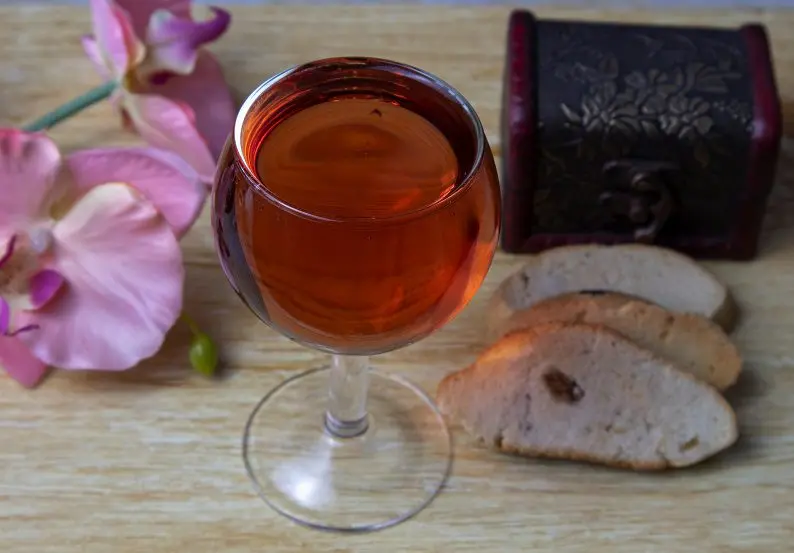Due to the high content of malic acid in the stems (edible part) of the plant, homemade rhubarb wine tastes like apple wine, but has a reddish tint. But many winemakers who have tried to make this drink complain about the herbal taste. We will consider a recipe in which this disadvantage is leveled by heat treatment.
Rhubarb of any variety will do, as long as the stems are ripe and juicy. Leaves and other parts can not be used, because they spoil the taste.
Ingredients:
- rhubarb stalks – 3 kg;
- water – 1 liter per 1 liter of juice;
- sugar – 0,5 kg per 1 liter of juice;
- unwashed raisins (fresh berries) – 30-50 grams (for sourdough).
The proportions of water and sugar are tied to the amount of rhubarb juice, which we get at the second stage of preparation. Wild yeast live on the surface of raisins or berries, activating fermentation. Due to the poor quality of store-bought raisins, it is better to use berries (raspberries, strawberries, cherries). If you add ordinary yeast, you get mash, not wine.
rhubarb wine recipe
1. 3-5 days before working with rhubarb, make wine sourdough. To do this, put unwashed raisins or berries (so that wild yeast remains on the peel) into a jar, add 25 grams of sugar and pour 100-150 ml of water at room temperature. Cover the jar with gauze, put in a warm place. When foam, a slight sour smell and hiss appear, the starter is ready, you can proceed to the next step.
If after 3-4 days there are no signs of fermentation (it happens when raisins or berries are heavily processed with chemicals), you need to make the starter again from other raw materials.
2. Wash the rhubarb stalks, remove the “white leg”, cut into small pieces (as small as possible). Put the pieces in a saucepan, pour water (should cover a layer of rhubarb by 2-3 cm, depending on the capacity). Remember the added amount of water, so that later you can correctly calculate the proportions.
Bring to a boil, cook over low heat until the stalks are soft. Remove the saucepan from the stove, cover with a lid, and cool to room temperature.
Due to the heat treatment, the herbal flavor disappears from the rhubarb and a light apple aroma appears.
3. Drain the broth into a separate container. Grind the stems with a blender or grind through a sieve.
4. In a container with a wide neck, mix chopped rhubarb, decoction, water (minus used during cooking), 200 grams of sugar per 1 liter of decoction and sourdough (pour along with raisins or berries). Cover the neck with gauze or cloth to protect against insects.
Transfer the wort to a dark room at room temperature. Leave for 3-4 days. Stir once a day with a clean hand or wooden stick.
5. Filter the wort through several layers of gauze. Press the pulp well and discard. Add 100 grams of sugar per 1 liter of juice (obtained after boiling) to the liquid part, mix.
6. Pour the wort into a fermentation tank, fill to a maximum of 75% to leave room for carbon dioxide and foam. Install a water seal on the neck or a medical glove with a hole in the finger (pierce with a needle) to remove carbon dioxide. Leave the container in a dark place with a temperature of 18-27°C.

7. After 5 days, add a new portion of sugar (100 grams per liter of juice after boiling): remove the water seal or glove, drain approximately 0,5 liters of must separately, dilute sugar in it, pour the resulting syrup back and close with a water seal. After another 5 days, repeat the procedure by adding the remaining sugar (100 grams per liter).
Depending on temperature and yeast activity, rhubarb wine will ferment for 25-60 days. Then the water seal stops bubbling (the glove deflates), a layer of sediment appears at the bottom, and the drink itself becomes lighter.
Attention! If fermentation continues 50 days after the installation of the water seal, so that bitterness does not appear, you need to drain the drink from the sediment and put it under the lock again to ferment at the same temperature.
8. Drain the fermented wine from the sediment (filter) through a tube into another container. To taste. If desired, sweeten with sugar or fix with vodka (alcohol) in an amount of 2-15% of the drink volume. Fortified wine is tougher in taste and not as fragrant, but it is better stored.
9. Fill storage containers with wine (preferably up to the neck so that there is no contact with air). Close hermetically, if sugar was added at the previous stage, it is better to keep the first 7-10 days under the shutter in case of repeated fermentation.
10. Transfer the wine to a dark room with a temperature of 5-16°C and leave for 3-6 months to mature. Once every 10-30 days, as sediment appears at the bottom with a layer of 3-5 cm, filter the wine by pouring it through a straw.
11. When the sediment no longer appears, the wine is ready. It can be bottled and hermetically sealed. When stored in a refrigerator or cellar, the shelf life of homemade rhubarb wine is up to 5 years. Fortress – 11-12%. According to the proportions in the recipe, approximately 2,5 liters of drink are obtained.










